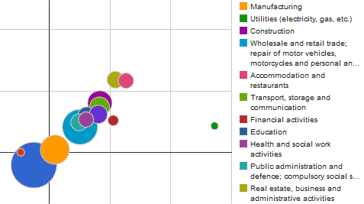World Employment and Social Outlook - Trends 2015
Private sector services and the care economy, key engines of job creation
ILO report points to accelerating job growth in private sector services over the next 5 years and an increasing demand for higher-skilled workers.

These and related industries will employ more than a third of the global workforce over the next five years.
Public services in health care, education and administration will continue to be a major source of employment. While increasing at a slower pace, they will still represent 15 per cent of total employment.
In contrast, the report said that industrial employment is expected to stabilize globally at slightly below 22 per cent.
Service sector employment will remain the most dynamic with respect to job creation in the next five years."
Raymond Torres, ILO Research Department
“Service sector employment will remain the most dynamic with respect to job creation in the next five years,” said Raymond Torres, head of the ILO Research Department.
Rising share of high-skilled occupations and impact on wages and inequality
The shift of employment to services and the decline in manufacturing means a significant change in the skills demanded by the labour market.“There will be a hollowing out of jobs needing medium levels of skill for routine tasks that can be automated,” Torres explained.
Individuals who once occupied these jobs will need to acquire new skills or instead face the prospect of competing for jobs at the lower end of the skill spectrum.
There is also growing demand for jobs that require face-to-face interaction, such as in health and personal services. This signals the emergence of a large care economy.
The global trends show significant regional variations, with medium-skilled jobs disappearing in advanced economies at a faster pace than is the case in emerging and developing countries.
This polarization between higher and lower-skilled jobs is having a direct impact on labour incomes. The increase in jobs at both the lower and upper ends of the skills ladder, at the expense of those in the middle, has and will continue to contribute to widening income inequality.
Consumption and poverty
Employment shifts also affect consumption and poverty levels. The number of routine jobs, such as machine operator or assembler has decreased in many countries, raising concerns over the role of manufacturing in helping workers to escape poverty.Without manufacturing jobs, opportunities for rural workers to improve their employment situation will be scarce.
Higher-skilled occupations are not accessible to those who lack formal education and have not opportunities for training.
“These trends highlight the role of policies to help enterprises and workers seize the opportunities associated with new technology, while at the same time breaking barriers for moving up the economic and social ladder, especially for women,” Torres concluded.